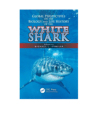Several occurrences of White Sharks in tropical waters have been reported, but in the context of gaps in the knowledge of the ecology of that top predator, they appear as unusual and unexpected destinations. The New Caledonian exclusive economic zone covers 1,400,000 km2, with sea-surface temperatures oscillating between 20 and 21°C in winter and 28 and 32°C in summer. We have validated fifty-two sightings of White Sharks between 1943 and 2010, mainly based on professional fishing bycatches and observations at sea. We obtained information on season in thirty-nine cases, shark size in forty-seven cases, and gender in twelve cases. To this, we added information for six different animals that were tagged with pop-up archival tags in New Zealand in April 2005 (two sharks) and March 2009 (four sharks), before releasing their tags in New Caledonian waters a few months later. Fifty-two percent of the animals were spotted in winter (July to September), 26% in spring (October to December), 23% in summer (January to March), and none in fall (April to June), which corresponds with the best season for tagging them in New Zealand. Thirty-two percent of the sharks were shorter than 3.8 m total length (TL), 45% between 3.8 and 4.4 m TL, 15% between 4.5 and 5 m TL, and 8% above 5 m TL. The smallest animal was 2.6 m TL and the largest was 5.5 m TL. The sex ratio was unbalanced, with twelve males and six females. As in other tropical islands, the peak presence of White Sharks in winter coincided with that of humpback whales that come to mate and calve in New Caledonian waters in winter before leaving in October. The extended presence of White Sharks until the end of summer could be linked to other sources of food such as spawning aggregations of reef fishes and deep-sea snappers, in addition to other usual prey. New Caledonian waters appear to be a wintering ground for South Pacific White Sharks, and the study of their ecology should be addressed at a regional level for providing critical information aimed at ensuring their sustainable management in this part of the world.
Liste




 English
English